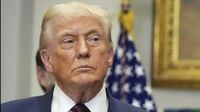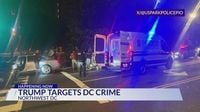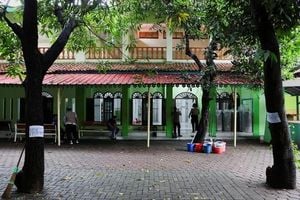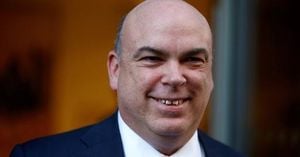On Monday, Washington, D.C. is set to become the epicenter of a heated debate over crime, governance, and federal power, as President Donald Trump prepares to address the nation from the White House. The president’s upcoming press conference, announced via his Truth Social account on Saturday, has already triggered a flurry of reactions, both supportive and critical, from city officials, activists, and the broader public. Trump’s message was unequivocal: “On Monday, a Press Conference will be held at the White House, which will, essentially, stop violent crime in Washington, D.C. It has become one of the most dangerous cities anywhere in the World. It will soon be one of the safest!!!”
This bold promise comes on the heels of a marked increase in federal law enforcement presence throughout the city, a move the White House says is designed to combat what it describes as an ongoing and unacceptable wave of violent crime. According to DC News Now, federal officers began ramping up patrols on Thursday, with plans to maintain heightened vigilance for at least a week. White House Press Secretary Karoline Leavitt, in comments reported by the Associated Press, called D.C. “an amazing city,” but added that “it has been plagued by violent crime for far too long.”
The sense of urgency from the Trump administration is echoed by Vice President JD Vance, who took to social media to highlight D.C.’s homicide rate, citing a figure of 41 per 100,000 people—significantly higher than major cities such as Lima, Havana, Nairobi, and Mexico City, all of which reported rates under 15 per 100,000. “Our nation’s capital has some of the worst homicide rates in the world,” Vance declared. “If this fact doesn’t anger you but President Trump’s efforts to fix it do, you might have a brain worm.”
Yet, the story of crime in D.C. is more complicated than a single statistic. As recently as January, the U.S. State’s Attorney for the District of Columbia announced that 2024 marked a 30-year low in violent crime for the city, with rates down 35% from the previous year. In fact, as of Friday, August 8, 2025, violent crime in the district was down 26% compared to 2023 levels, according to the Metropolitan Police Department. Breaking it down further: homicides dropped by 32%, robberies by 39%, armed carjackings by 53%, and assaults with a dangerous weapon by 27%. The State’s Attorney’s office emphasized, “The District is reporting the fewest assaults with dangerous weapons and burglaries in over 30 years.”
Still, the city’s crime rates remain a source of national scrutiny, especially when compared to other major U.S. cities. A DC News Now analysis found that, between January and August this year, D.C.’s homicide rate stood at 13.7 per 100,000 residents—higher than Los Angeles (4.1) and New York City (2.11). Similarly, robbery rates were higher in D.C. (123.5 per 100,000) than in LA (111.4) or NYC (103.3). However, D.C. fared better on assaults and rapes, with lower rates than the other two cities: assaults in D.C. were 73.2 per 100,000, compared to 204 in New York and 233 in LA.
Against this backdrop, the Trump administration’s approach has been twofold. First, it’s deploying more federal law enforcement officers to the city. Second, and more controversially, Trump has floated the idea of a federal takeover of Washington, D.C.—a prospect that would require repealing the Home Rule Act of 1973. This law, established to give D.C. residents a measure of self-governance, allows them to elect their own mayor and city council, though Congress retains the authority to override local laws and budgets. As Bloomberg points out, such a federal intervention would need congressional approval and would represent a significant shift in the balance of local and federal power.
Trump’s rhetoric has grown sharper in recent weeks, particularly after a former Department of Government Efficiency employee was reportedly beaten in an attempted carjacking earlier this month. The president posted a photo of the bloodied former staffer, warning, “If D.C. doesn’t get its act together, and quickly, we will have no choice but to take Federal control of the City, and run this City how it should be run, and put criminals on notice that they’re not going to get away with it anymore.”
Not everyone is on board with the administration’s tough stance or its hints at a federal takeover. The advocacy group Free DC has announced plans to protest outside the White House on Monday morning, starting at 10 a.m. in the public plaza north of Lafayette Square. Their demonstration is intended to push back against what they see as a threat to the district’s autonomy and a disregard for the progress made in reducing crime. Both the mayor’s office and the Metropolitan Police Department have so far declined to comment publicly on the president’s proposals or the increased federal presence.
Meanwhile, the Trump administration is pursuing other changes in the capital. According to Audacy, the National Park Service recently announced plans to restore the statue of Confederate general Albert Pike to its original location at 3rd and D Streets NW, five years after it was toppled by protestors. In addition, Trump has revealed ambitions to build a $200 million ballroom at the White House, signaling a desire to leave a lasting mark on the city’s landscape.
While the president’s supporters argue that decisive federal action is necessary to secure the capital and restore order, critics warn that such measures risk undermining local democracy and inflaming tensions. The debate has drawn in voices from across the political spectrum, with some emphasizing the need for public safety and others insisting on the importance of self-determination for D.C. residents. The fact that violent crime has dropped significantly over the past year has led some to question the urgency and motives behind the administration’s plans.
For now, all eyes are on Monday’s press conference. Will Trump’s announcement mark the beginning of a new era of federal intervention in Washington, D.C., or will it instead galvanize local leaders and activists to defend the city’s hard-won autonomy? With crime rates, political power, and the future of the nation’s capital all on the line, the stakes could hardly be higher.
The coming days will reveal whether the president’s promises translate into lasting change—or whether the debate over D.C.’s fate is just getting started.





